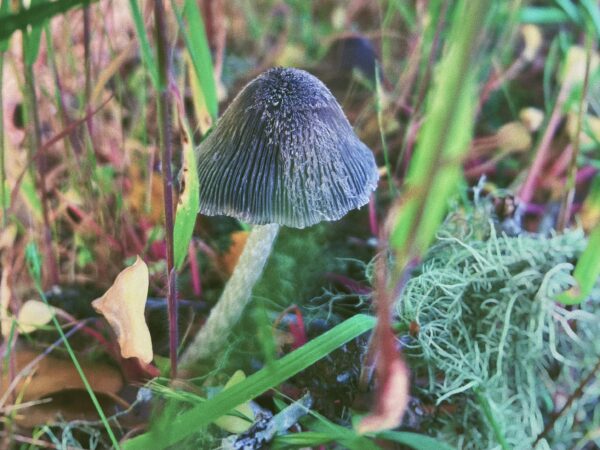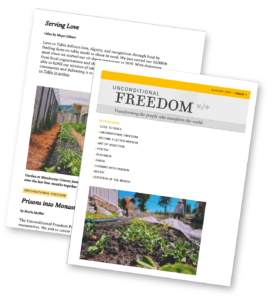by Kate Feigin
Kate Feigin, MSW, is the Prison Monastery Director for Unconditional Freedom; 17-year criminal justice veteran; Former Restorative Justice Manager Mendocino County Jail; Human Services faculty at Mendocino Community College; and PhD candidate Community Psychology Pacifica Graduate Institute
“If we are looking for models of self-sustaining communities, we need look no further than an old-growth forest. Or the old-growth cultures they raise in symbiosis with them.” -Robin Wall-Kimmerer’s Braiding Sweetgrass
When I first stepped inside a correctional facility, I was 23 years old. I was working as an addictions counselor for incarcerated youth in juvenile hall. The first thing I noticed was how bright it was. The tables were made of stainless steel, and they were bolted to the floor. The harsh fluorescent lights bounced from the tables to the shiny walls to the polished concrete floors. The second thing I noticed was how loud it was. Angry voices bounced off of those same hard surfaces. I remember thinking about how it would feel to live in this environment as a young person, as a child who had no family with them, and coming to this place after a massive rupture in their life. I felt grief. I also felt determined to find a way to be a beacon of warmth while I was there, a one-woman sensory break from the harshness. I facilitated groups and individual sessions for youth struggling with addiction for 15 years at juvenile hall. In that time, I learned a lot about the carceral world, I also learned about liberation, purpose, and hope. I learned a lot about humans and their needs, and I learned what happens when those fundamental comforts are stripped away.
When I feel dysregulated or low about the heaviness of the world, I go outside and plant my bare feet on the ground. I close my eyes and listen for the wind rustling the trees. I feel the breeze on my face and the sun on my skin. I lie on my back and think about the mushrooms who are quietly recycling all things in the forest, turning it into rich soil as they whisper to one another under the ground, unnoticed as we thunder along in our harried existence.
I now work in adult correctional facilities and have visited many more jails and prisons over my 18-year career. I have noticed that all American correctional settings share one thing in common: they are largely removed from the natural world. There is no dirt in which to put your feet. There is no moss to sink into as you look up at the sky, and no birds wheeling above. “Yard time” for most inmates consists of walking in circles in a concrete box, a bit of sky visible above. No one is permitted to remove their shoes. I once witnessed an act of rebellion that brought me to tears: 8 inmates sitting in a circle out in the concrete yard, shoes removed and pants rolled up, soaking up the sun on their skin.
The words penal and penitentiary come from the Latin root of pænitentia, which means “repentance” and “sorrow for committing sin or for having offended, with the intention of amending one’s life.” A prison was meant to be a place of quiet reflection, growth through hard work, and sorrowful penitence. Over time, the prison environment moved from this penitence model to a warehousing model as prison populations rose and prison labor became monetized. In the process, the original intent for correctional institutions was lost: it is not intended to nourish or heal the soul, it is designed to punish and deprive.
In making progress, we have lost our way. Since the rise of capitalism, we humans have often confused ideas of progress with the spread of practices that turn both ourselves and “earth others” into resources. These practices have separated humans and non-humans, hindering collaborative survival. We have forgotten that, as John Muir so beautifully states, “When we try to pick out anything by itself, we find it hitched to everything else in the Universe.” When we see nature as a part of us and that our relationship should be reciprocal, we can open new ways of being, and we can see nature as our teacher, rather than an entity to be tamed.
I have been thinking a lot about mushrooms lately, and how they bravely work together, turning decay and rot and ugliness into purpose. If we stoop down low and inhale the earthy scent of the forest floor, there is wisdom there. The mycelial networks just under the surface might have a solution to the social problems that have evolved in our prison system. Mycelium has a lot to teach us about communication, community, sustainability, and turning the discarded into something useful.
When I walk through the forest, I dream about a return to a carceral setting that nurtures the human spirit, one that provides the germination conditions for flourishing to occur. The first cue we can take from mushrooms is to move from an individual mindset to a collective one where we cease to pathologize incarcerated individuals, and begin to look at the ways in which the system as a whole is in need of healing. Existing in the fluid identity between animal and vegetable, mushrooms have a lot to teach us about community. As we humans plunder and extract the earth’s resources, mushrooms are quietly recycling and repurposing. They decompose dead and dying organisms, moving all of the nutrients back into the cycle. Mushrooms represent regeneration and rebirth: existing in the sacred place where life ends and life begins.
Anna Tsing writes in The Mushroom at the End of the World, “We are stuck with the problem of living despite economic and ecological ruination. Neither tales of progress nor of ruin tell us how to think about collaborative survival. It is time to pay attention to mushroom(s). Not that this will save us — but it might open our imaginations.”
Fungi are seasoned veterans of ecological devastation. Their ability to survive and thrive, adapt through massive ecological changes, is one of their defining characteristics. They are creative, resourceful, and collaborative. A growing number of mycologists believe that mushrooms might hold wisdom about how to heal, regenerate, find purpose, and thrive. Throughout our planet’s history, collaboratives have formed in times of crisis and ruin. We can look to nature’s partnerships to gain insight into our complex problems. Lichens are not able to find purchase on a slippery rock face without the help of friendship with a fungus. Similarly, a person who is displaced from their roots through incarceration will find growth and healing through an intentional community within the prison.
A mycelial network is a map of a fungus’s recent history and is a helpful reminder that all life-forms are in fact processes not things. The “you” of five years ago was made from different stuff than the “you” of today. Nature is an event that never stops. This is an important reminder for all of us. We are capable of transformation even in the harshest of environments. The modern carceral setting is one of the toughest places to heal from trauma and transform. The correctional landscape feels desolate, quite like degraded landscapes we can find all over the world.
Anna Tsing writes of how these disregarded lands can serve as reminders of our potential to nurture: “The ruin glares at us with the horror of its abandonment. It’s not easy to know how to make a life, much less avert planetary destruction. Luckily there is still company, human and not human. We can still explore the overgrown verges of our blasted landscapes — the edges of capitalist discipline, scalability, and abandoned resource plantations. We can still catch the scent of the latent commons — and the elusive autumn aroma.”
What if we viewed prisons as a crucial site of decay and rebirth? It is only in decay that rebirth is possible. What if we created correctional environments that were filled with opportunities to break down and come through pain rather than to numb, avoid, and dissociate? What if we learn from mycelial wisdom and embrace the darkness, the messiness, the ugliness and use it to fuel a new purpose? What if people in prison were seen as essential for the transformation of humanity? What if incarcerated people became active co-creators of transformation on a larger societal scale? A new paradigm might emerge in dialogue with living systems and their ontologies.
Mushrooms teach us not to be afraid of the dark. They teach us to embrace it; to bravely enter the circle of community and create new life.
We know in the depths of our being that all flourishing is mutual and all healing is reciprocal. As we heal the world, the world heals us.

 Get access to the monthly Rehumanization Magazine featuring contributors from the front lines of this effort—those living on Death Row, residents of the largest women’s prison in the world, renowned ecologists, the food insecure, and veteran correctional officers alike.
Get access to the monthly Rehumanization Magazine featuring contributors from the front lines of this effort—those living on Death Row, residents of the largest women’s prison in the world, renowned ecologists, the food insecure, and veteran correctional officers alike.